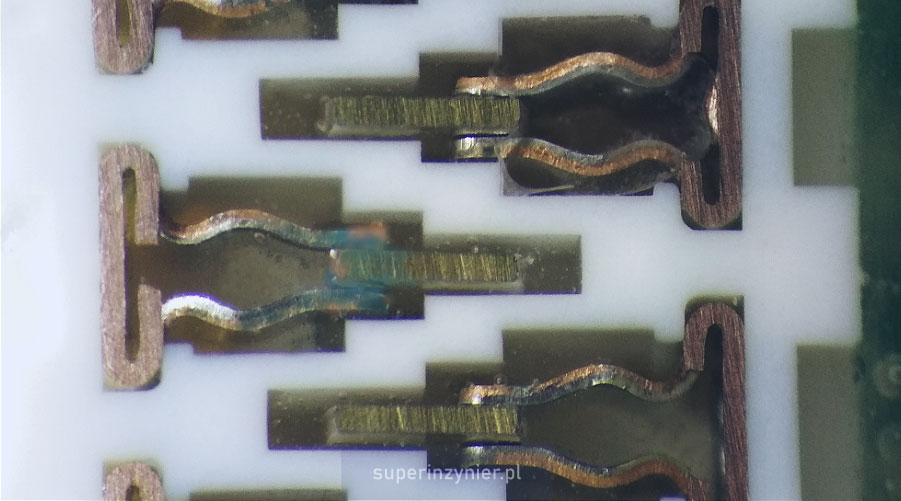Introduction
Corrosion of electrical connectors contacts is a phenomenon that significantly affects the reliability of electrical devices. The materials used for coatings, environmental conditions, and operational parameters have a significant impact on the occurrence of corrosion. The result of corrosion is the formation of various deposits on contact surfaces, typically layers of oxides, sulfides, and chlorides. These chemical compounds have high resistance, preventing the flow of electrical current. This article discusses the most common types of corrosion of electrical connectors contacts.
What is Corrosion?
Corrosion is defined as the "process of degradation of materials due to chemical or electrochemical reactions occurring at the interface with the surrounding environment"[1]. Depending on the type of material and the environment it interacts with, corrosion can be based on various mechanisms: chemical, electrochemical, mechanical (friction), microbiological, etc.
Types of Connector Corrosion
Chemical Corrosion
This type of corrosion involves the destruction of metal surfaces in environments lacking ionic conductivity (i.e. without a humid electrolytic environment). For example, the presence of sulphur in the air causes the formation of silver sulphide on the surface of silver contacts. Silver sulphide has a high resistance, which poses a problem for low-voltage electrical signals. Therefore, silver-plated contacts are not a good choice for connectors used in the transmission of data or low-amplitude analogue signals.
Sulfur corrosion of SMD resistors is known to be encountered in electronics.
Electrochemical Corrosion
The surface of metals is not perfectly homogeneous, containing various impurities, inclusions, etc. Metals have a granular (crystalline) microstructure, and grain boundaries have different energy levels compared to the interior of these grains. If such a granular surface is covered with an electrolyte (e.g., water containing chlorides), a "micro-cell" is formed, initiating the electrochemical corrosion process. The grain boundary then becomes the anode (+) and the interior of the grain becomes the cathode (-). This phenomenon causes corrosion of the surface of the metal (contacts). This type of corrosion is also referred to as "general corrosion" or "uniform corrosion" since it usually occurs on the entire surface of the metal exposed to specific environmental conditions. Minimizing electrochemical corrosion in electrical connectors involves the following actions:
- Selection of suitable connector pin finish.
- Reduction of moisture ingress, e.g., by using sealed housings, potting, etc.
- Minimization of ionic impurities during the soldering and assembly of the connectors. For example, avoid contaminating the contacts with soldering flux.
Pitting corrosion
This is a kind of electrochemical corrosion occurring only in certain areas of the contact where other phenomena have previously occurred causing local discontinuity of the protective finish. Typically these are: non-metallic inclusions (e.g. sulphides), cracks in the material in the lead bend area, abrasion of the plating, excessive porosity of the protective finish, etc. Mitigation measures include:
- Selecting an adequate connector pin finish for the application (finish material, finish thickness, underplate).
- Assembling the connectors with sufficient care to avoid damaging the contacts.
- Minimising the effects of moisture and ionic contamination from assembly processes.
Galvanic Corrosion
A particular type of electrochemical corrosion is 'contact' galvanic corrosion. A galvanic cell is formed when two different metals (with different electrochemical potentials) come into contact with each other in an electrolyte environment[2]. In electrical connectors, this type of corrosion occurs when the contacts of the male and female connectors have different material of finish. The greater the potential difference between the metals being joined, the faster galvanic corrosion occurs. Therefore, connector contacts with different finish should not be connected together.
Fretting corrosion
Fretting corrosion is a type of mechanical corrosion that can occur in tin-plated connectors. It involves the build-up of tin oxides in the contact area, which form a barrier preventing the passage of low-voltage electrical signals. The formation of tin oxides is related to the micro-movement of the contacts (vibration, change of ambient temperature) and the low contact pressure force against the contacts. Actions to reduce the risk of fretting corrosion include:
- Change to a finish material other than tin.
- Selecting connectors with high contact force.
- Lubricating the contact area with a special oil that reduces oxygen ingress, thus reducing the amount of tin oxides.
Electro-Chemical Migration
Electro-Chemical Migration (ECM) is a phenomenon, often colloquially referred to as corrosion, which can occur between electrically isolated adjacent contacts of a connector. The prerequisite for this phenomenon is the presence of an electrolyte (moisture and ions) and, of course, an electrical potential. For more information, see the article: Dendrites and corrosion in electronics.
Summary
Corrosion of connector contacts is a phenomenon that significantly reduces equipment reliability. The correct choice of connector contacts, finish materials and adequate protection from the external environment are key aspects to consider when designing reliable electrical and electronic systems.
References
- https://encyklopedia.pwn.pl/haslo/korozja;3925930.html
- https://knowledge.electrochem.org/encycl/art-c02-corrosion.htm




